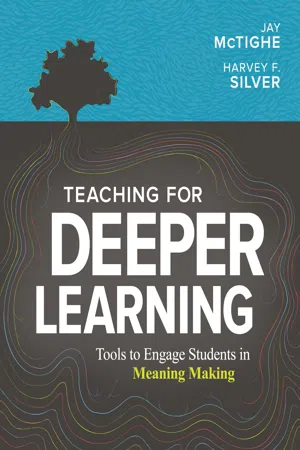
Teaching for Deeper Learning
Tools to Engage Students in Meaning Making
- 130 pages
- English
- ePUB (mobile friendly)
- Available on iOS & Android
About This Book
Far too often, our students attain only a superficial level of knowledge that fails to prepare them for deeper challenges in school and beyond. In Teaching for Deeper Learning, renowned educators and best-selling authors Jay McTighe and Harvey F. Silver propose a solution: teaching students to make meaning for themselves.
Contending that the ability to "earn" understanding will equip students to thrive in school, at work, and in life, the authors highlight seven higher-order thinking skills that facilitate students' acquisition of information for greater retention, retrieval, and transfer. These skills, which cut across content areas and grade levels and are deeply embedded in current academic standards, separate high achievers from their low-performing peers.
Drawing on their deep well of research and experience, the authors - Explore what kind of content is worth having students make meaning about.
- Provide practical tools and strategies to help teachers target each of the seven thinking skills in the classroom.
- Explain how teachers can incorporate the thinking skills and tools into lesson and unit design.
- Show how teachers can build students' capacity to use the strategies independently.
If our goal is to prepare students to meet the rigorous demands of school, college, and career, then we must foster their ability to respond to such challenges. This comprehensive, practical guide will enable teachers to engage students in the kind of learning that yields enduring understanding and valuable skills that they can use throughout their lives.
Frequently asked questions
Information
Framing Learning Around Big Ideas
Focus on Big Ideas
- There is simply too much information to be able to cover it all in school. The explosion of knowledge means that we can address only a relatively small amount of all possible content, especially in history and the STEM subjects (science, technology, engineering, and math). This makes it imperative to identify the big ideas that are essential for students to understand and to focus instruction accordingly.
- Trying to cover too much content can result in superficial and disengaged learning. By contrast, when we focus on fewer but bigger ideas and transferable skills, we have more time to engage students actively in making meaning of those big ideas. Moreover, we can expand the use of performance tasks that involve students in applying their learning in authentic and meaningful ways, leading to deeper learning and transfer abilities.
- An emphasis on larger ideas reflects our understanding of how knowledge is best structured for retention and use. Research on how experts' knowledge is organized relative to that of novices reveals that "[experts'] knowledge is not simply a list of facts and formulas that are relevant to their domain; instead, their knowledge is organized around core concepts or 'big ideas' that guide their thinking about their domains" (National Research Council, 2000, p. 36).
- The rapid changes and unpredictability of the modern world call for learners who will be able to transfer their learning. Rote learning of factual information will not, by itself, equip learners to effectively apply it to new situations. Because transfer requires an understanding of broader concepts and generalizations, teaching for transfer requires focusing on conceptually bigger ideas.
Concept-Based Curriculum Design
- A Study In … encourages teachers to plan their units to focus on the key concepts to be understood rather than just topics, skills, or texts.
- Concept Word Wall reminds teachers to identify the key concepts that will help students develop a deep understanding of the content—and to make those concepts visible in the classroom.
- Essential Questions shows teachers how to frame their content around open-ended and thought-provoking questions that help students make meaning of and "uncover" the big ideas.
A Study In …
- Argument Writing: A Study in Craftsmanship
- Impressionism: A Study in Revolution
- The Four Seasons: A Study in Change
- The Pentagon Papers: A Study in Deception
- Four Films by Hitchcock: A Study in Obsession
- Weight Training: A Study in Proper Technique
- Whole Numbers: A Study in Rules and Relationships
- Formal Versus Informal Forms of Address in Spanish: A Study in Respect
Figure 1.1. Examples of Transferable Concepts and Themes
acceptance/rejection
adaptation
balance
caring
cause and effect
challenge
change/continuity
character
communication
community
competition
composition
conflict
convergence
cooperation
correlation
courage
craftsmanship
creativity
culture
cycles
defense/protection
democracy
design
discovery
diversity
environment
equality/inequality
equilibrium
equivalence
ethics
evolution
exploitation
exploration
fairness
freedom
friendship
harmony
honor
interactions
interdependence
interpretation
invention
justice
liberty
loyalty
maturity
mood
movement
needs and wants
order
organization
parts and wholes
patriotism
patterns
perseverance
perspective
prejudice
production/consumption
relationships
renewal
repetition
representation
revolution
rhythm
structure and function
supply and demand
survival
symbiosis
systems
tyranny
Concept Word Wall
Essential Questions
Table of contents
- Cover
- Title Page
- Table of Contents
- Praise
- Dedication
- Acknowledgments
- Preface
- Introduction
- 1. Framing Learning Around Big Ideas
- 2. Conceptualizing
- 3. Note Making and Summarizing
- 4. Comparing
- 5. Reading for Understanding
- 6. Predicting and Hypothesizing
- 7. Visualizing and Graphic Representation
- 8. Perspective Taking and Empathizing
- 9. Putting It All Together
- References
- Related ASCD Resources
- About the Authors
- Copyright